Packaged Fresh Fruits Market
Packaged Fresh Fruits Market Size and Share Forecast Outlook 2025 to 2035
Packaged fresh fruits market is projected to grow from USD 14.5 billion in 2025 to USD 25.2 billion by 2035, at a CAGR of 5.7%. Apples will dominate with a 18.0% market share, while natural will lead the nature segment with a 50.0% share.
Packaged Fresh Fruits Market Forecast and Outlook 2025 to 2035
The global packaged fresh fruits market is valued at USD 14.5 billion in 2025 and is set to reach USD 25.3 billion by 2035, recording an absolute increase of USD 10.8 billion over the forecast period. This translates into a total growth of 74.5%, with the market forecast to expand at a CAGR of 5.7% between 2025 and 2035.
The overall market size is expected to grow by approximately 1.7 times during the same period, supported by increasing consumer preference for convenient food options, growing health consciousness, and rising demand for ready-to-eat fruit products across retail and foodservice channels.
Quick Stats for Packaged Fresh Fruits Market
- Packaged Fresh Fruits Market Value (2025): USD 14.5 billion
- Packaged Fresh Fruits Market Forecast Value (2035): USD 25.3 billion
- Packaged Fresh Fruits Market Forecast CAGR: 5.7%
- Leading Variety Category in Packaged Fresh Fruits Market: Apples (18.0%)
- Key Growth Regions in Packaged Fresh Fruits Market: Asia Pacific, North America, Europe
- Key Players in Packaged Fresh Fruits Market: Dole Foods, Fresh Del Monte, Chiquita, Sun-Maid, Ocean Spray
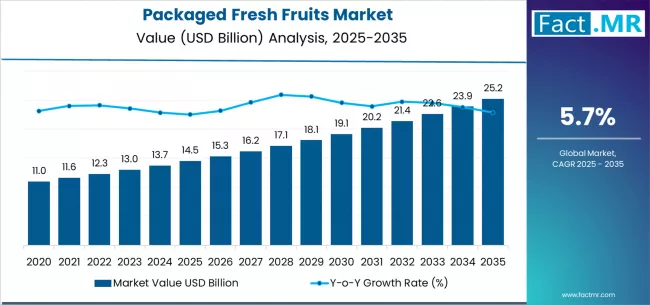
The global packaged fresh fruits market represents a vital segment within the fresh produce and convenience food industry, driven by evolving consumer lifestyles and the growing focus on healthy eating habits. These products encompass pre-cut, pre-washed, and portioned fresh fruits that are packaged in various formats including plastic containers, bags, and trays with modified atmosphere packaging to extend shelf life. The packaging technology enables convenient consumption while maintaining nutritional value and freshness, making these products particularly suitable for busy consumers seeking healthy snack alternatives and time-saving food preparation solutions.
The market encompasses various fruit varieties, packaging formats, and distribution channels tailored for different consumer segments and retail environments. Modern packaged fresh fruit products incorporate advanced packaging technologies, including vacuum sealing, controlled atmosphere packaging, and antimicrobial films that preserve fruit quality while extending shelf life beyond traditional fresh produce. The integration of transparent packaging materials, portion control features, and consumer-friendly labeling has further enhanced the appeal of these products among health-conscious consumers seeking nutritional transparency and convenience.
Market dynamics are significantly influenced by changing consumer eating patterns, particularly the shift toward healthy snacking options, on-the-go consumption preferences, and increasing awareness of nutritional benefits associated with fresh fruit consumption. The retail sector's focus on fresh produce merchandising, convenience store expansion, and premium product positioning has created substantial demand for high-quality packaged fruit solutions across supermarkets, convenience stores, and specialty food retailers. The growing trend toward organic and natural food products has amplified the need for certified organic packaged fruits that meet consumer expectations for quality and health benefits.
Consumer purchasing patterns show a marked preference for variety packs that combine multiple fruit types, single-serve portions suitable for individual consumption, and premium packaging that maintains fruit appearance and freshness throughout the retail cycle. The market has witnessed significant innovation in packaging design, preservation technology, and product presentation, making these items more appealing to diverse consumer demographics across different income levels and lifestyle preferences
Between 2025 and 2030, the market is projected to expand from USD 14.5 billion to USD 18.9 billion, resulting in a value increase of USD 4.4 billion, which represents 40.7% of the total forecast growth for the decade. This phase of development will be shaped by increasing health awareness adoption, rising demand for convenient snacking solutions, and growing availability of premium packaged fruit varieties across retail channels and foodservice applications.
Between 2030 and 2035, the market is forecast to grow from USD 18.9 billion to USD 25.3 billion, adding another USD 6.4 billion, which constitutes 59.3% of the overall ten-year expansion. This period is expected to be characterized by the advancement of smart packaging technologies, the development of extended shelf-life solutions for international distribution, and the expansion of organic and premium fruit categories across diverse retail formats. The growing focus on food safety and traceability will drive demand for advanced packaged fruit varieties with enhanced quality assurance features, improved preservation characteristics, and superior nutritional retention profiles.
Between 2020 and 2024, the market experienced accelerated growth, driven by changing consumer behavior during health-focused periods and growing recognition of packaged fruits' convenience advantages in busy lifestyle applications following extensive retail expansion campaigns. The market developed as consumers recognized the benefits of pre-packaged fruit options over traditional bulk purchases in time-sensitive shopping environments and began seeking specialized varieties designed for specific nutritional and convenience requirements. Technological advancement in packaging materials and preservation methods began emphasizing the critical importance of maintaining fruit quality while enhancing shelf life and improving consumer satisfaction across diverse fresh produce applications.
Packaged Fresh Fruits Market Key Takeaways
| Metric | Value |
|---|---|
| Estimated Value in (2025E) | USD 14.5 billion |
| Forecast Value in (2035F) | USD 25.3 billion |
| Forecast CAGR (2025 to 2035) | 5.7% |
From 2030 to 2035, the market is forecast to grow from USD 18.9 billion to USD 25.3 billion, adding another USD 6.4 billion, which constitutes 59.3% of the overall ten-year expansion. This period is expected to be characterized by the advancement of sustainable packaging integration, the integration of blockchain technology for supply chain transparency, and the development of specialized fruit combinations for targeted health applications. The growing focus on nutritional optimization and product innovation will drive demand for premium varieties with enhanced vitamin content, improved taste profiles, and superior convenience characteristics.
Between 2020 and 2024, the packaged fresh fruits market experienced robust growth, driven by increasing awareness of healthy eating benefits and growing recognition of convenience packaging's effectiveness in supporting modern consumer lifestyles across retail and institutional foodservice applications. The market developed as users recognized the potential for packaged fresh fruits to deliver nutritional advantages while meeting contemporary requirements for food safety and convenient consumption. Technological advancement in preservation techniques and packaging innovation began emphasizing the critical importance of maintaining nutritional integrity while extending product availability and improving user satisfaction across diverse fresh fruit applications.
Why is the Packaged Fresh Fruits Market Growing?
Market expansion is being supported by the increasing global focus on health and wellness and the corresponding shift toward convenient nutrition solutions that can provide superior fresh fruit benefits while meeting consumer requirements for time-saving food preparation and portable snacking options. Modern consumers are increasingly focused on incorporating fruit products that can enhance daily nutrition while satisfying demands for convenient, portion-controlled consumption and optimized meal planning practices. Packaged fresh fruits' proven ability to deliver nutritional excellence, convenience benefits, and diverse consumption possibilities makes them essential components for health-focused households and quality-focused retail environments.
The growing focus on clean eating trends and nutritional transparency is driving demand for high-quality packaged fruit products that can support distinctive health outcomes and comprehensive nutrition management across snacking applications, meal preparation, and premium food experiences. Consumer preference for fruit solutions that combine nutritional excellence with convenience is creating opportunities for innovative implementations in both traditional and emerging retail applications. The rising influence of busy lifestyles and health awareness campaigns is also contributing to increased adoption of convenient fruit solutions that can provide authentic nutritional benefits and reliable quality characteristics.
Segmental Analysis
The market is segmented by variety, nature, distribution channel, packaging type, and region. By variety, the market is divided into apples, bananas, pineapples, berries, citrus fruits, and other varieties. Based on nature, the market is categorized into organic, natural, conventional, and others. By distribution channel, the market includes hypermarkets/supermarkets, online retail, convenience stores, and other retail formats. By packaging type, the market encompasses plastic containers, bags, trays, and specialty packaging configurations. Regionally, the market is divided into North America, Europe, Asia Pacific, Latin America, Middle East & Africa, and other regions.
By Variety, the Apples Segment Accounts for 18.0% Market Share
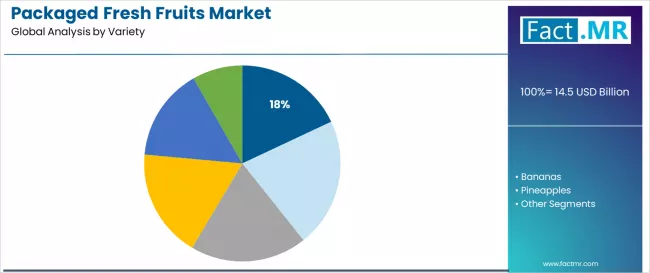
The apples segment is projected to account for 18.0% of the market in 2025, reaffirming its position as the leading variety category. Retailers and consumers increasingly utilize apple products for their superior shelf life characteristics, established popularity standards, and essential nutritional functionality in diverse packaged fruit applications across multiple retail sectors. Packaged apples' proven taste characteristics and established market acceptance directly address consumer requirements for familiar fruit options and optimal convenience in both individual and family consumption formats.
This variety segment forms the foundation of modern convenient fruit consumption patterns, as it represents the fruit type with the greatest consumer familiarity and established compatibility across multiple demographic segments. Consumer investments in healthy eating habits and convenience optimization continue to strengthen adoption among health-focused users. With retailers prioritizing product reliability and consumer acceptance, apple products align with both nutritional objectives and taste preferences, making them the central component of comprehensive packaged fruit strategies.
By Nature, Natural Segment Shows Strong Market Dominance
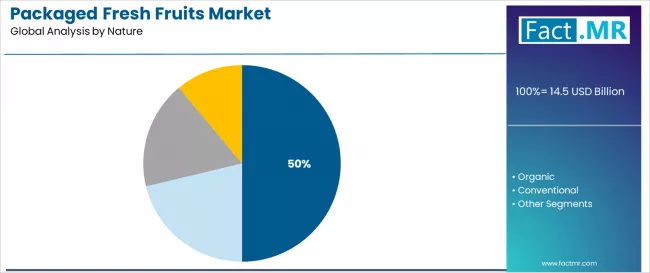
Natural is projected to represent 50.0% of the market in 2025, underscoring its critical role as the primary nature category for health-focused consumers seeking superior nutritional benefits and enhanced product quality credentials. Natural product consumers and health-conscious buyers prefer natural applications for their established quality requirements, proven nutritional value, and ability to maintain exceptional taste characteristics while supporting versatile consumption patterns during diverse eating occasions. Positioned as essential options for health-focused consumers, natural offerings provide both nutritional excellence and quality assurance advantages.
The segment is supported by continuous improvement in natural fruit processing and the widespread availability of established natural standards that enable quality assurance and premium positioning at the retail level. Natural product consumers are optimizing fruit selections to support health-specific applications and comprehensive nutrition strategies. As clean eating trends continue to advance and consumers seek authentic food products, natural applications will continue to drive market growth while supporting nutritional goals and quality optimization strategies.
By Distribution Channel, Hypermarkets/Supermarkets Segment Maintains Leadership
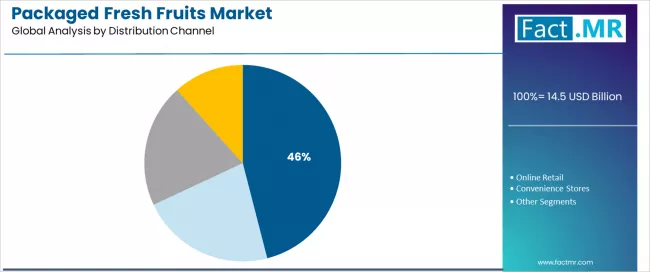
Hypermarkets/supermarkets is projected to represent 46.0% of the market in 2025, demonstrating its position as the dominant distribution channel for convenience-focused consumers seeking comprehensive fruit selection and competitive pricing advantages. Large format retailers and grocery chains prefer supermarket distribution for their established infrastructure capabilities, proven consumer traffic patterns, and ability to maintain exceptional product variety while supporting efficient supply chain operations during peak shopping periods. Positioned as primary destinations for grocery shopping, hypermarkets/supermarkets provide both product accessibility and price competitiveness benefits.
The segment benefits from continuous improvement in fresh produce merchandising and the widespread availability of established retail standards that enable product presentation excellence and consumer convenience at the store level. Hypermarket operators are optimizing fruit category management to support cross-merchandising opportunities and comprehensive shopping experiences. As retail consolidation continues to advance and consumers seek one-stop shopping convenience, hypermarket/supermarket distribution will continue to drive market growth while supporting accessibility objectives and retail efficiency strategies.
What are the Drivers, Restraints, and Key Trends of the Packaged Fresh Fruits Market?
The packaged fresh fruits market is advancing rapidly due to increasing health consciousness adoption and growing need for convenient nutrition solutions that emphasize superior fresh fruit benefits across retail segments and foodservice applications. The market faces challenges, including competition from fresh bulk fruit alternatives, packaging cost considerations, and shelf life limitations affecting product viability. Innovation in preservation technology enhancement and advanced packaging systems continues to influence market development and expansion patterns.
Expansion of Health-Conscious and Convenience-Focused Applications
The growing adoption of packaged fresh fruits with nutritional labeling and portion control features is enabling consumers to develop healthy eating strategies that provide distinctive convenience benefits while commanding optimal nutrition delivery and enhanced meal planning characteristics. Health-focused applications provide superior nutritional consistency while allowing more sophisticated dietary management features across various consumer categories. Users are increasingly recognizing the convenience advantages of pre-portioned fruit positioning for comprehensive nutrition outcomes and lifestyle-integrated meal planning.
Integration of Advanced Packaging and Preservation Technologies
Modern packaged fresh fruit manufacturers are incorporating advanced preservation films, modified atmosphere packaging capabilities, and freshness indicator systems to enhance product longevity, improve nutritional retention effectiveness, and meet consumer demands for extended shelf life solutions. These technologies improve product performance while enabling new applications, including extended distribution programs and international shipping protocols. Advanced packaging integration also allows retailers to support premium product positioning and quality assurance beyond traditional fresh produce requirements.
Analysis of the Packaged Fresh Fruits Market by Key Country
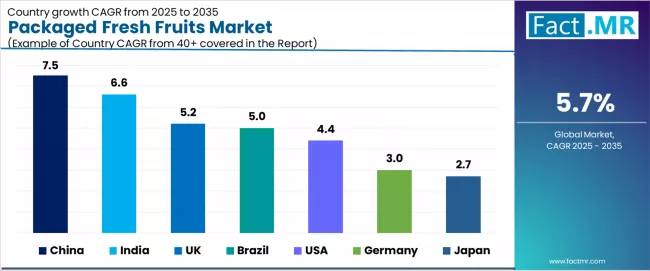
| Country | CAGR (2025-2035) |
|---|---|
| China | 7.5% |
| India | 6.6% |
| Germany | 3.0% |
| Brazil | 5.0% |
| USA | 4.4% |
| UK | 5.2% |
| Japan | 2.7% |
The market is experiencing robust growth globally, with China leading at a 7.5% CAGR through 2035, driven by the expanding urban population, growing middle-class purchasing power, and increasing adoption of Western convenience food trends. India follows at 6.6%, supported by rising disposable incomes, expanding retail infrastructure, and growing health awareness among urban consumers. Germany shows growth at 3.0%, emphasizing established retail systems and mature consumer preferences. Brazil records 5.0%, focusing on retail modernization and increasing health consciousness. The USA demonstrates 4.4% growth, prioritizing premium product categories and organic options.
The report covers an in-depth analysis of 40+ countries, top-performing countries are highlighted below.
How is China leading global market growth through the urban consumption revolution?
China is projected to exhibit exceptional growth with a CAGR of 7.5% through 2035, driven by the country's rapidly expanding urban population, favorable demographic trends toward health consciousness, and initiatives promoting convenient food consumption across major metropolitan regions. China's position as a growing consumer market and increasing focus on imported and premium food products are creating substantial demand for high-quality packaged fresh fruits in both domestic retail and premium market segments. Major food retailers and international fruit companies are establishing comprehensive distribution capabilities to serve growing demand and emerging premium opportunities.
- Established urban culture and expanding health consciousness are driving demand for packaged fresh fruits across modern retail formats, convenience stores, and comprehensive food distribution systems throughout Chinese consumer markets.
- Strong retail infrastructure and health adoption initiatives are supporting the rapid adoption of premium fruit products among affluent consumers seeking to meet evolving dietary preferences and nutrition requirements.
How is India demonstrating strong market potential through its focus on retail development?
India is expanding at a CAGR of 6.6%, supported by rising urbanization investment, growing health consciousness, and expanding retail distributor capabilities. The country's developing retail infrastructure and increasing investment in modern food distribution are driving demand for packaged fruits across both traditional and modern retail applications. International food companies and domestic retailers are establishing comprehensive operational networks to address growing market demand for convenient fruit products and healthy snacking solutions.
- Rising urban development and expanding retail capabilities are creating opportunities for packaged fresh fruit adoption across modern retail projects, supermarket developments, and distributor companies throughout major Indian metropolitan regions.
- Growing health awareness initiatives and convenient food technology advancement are driving the adoption of specialized fruit products and services among consumers seeking to enhance their nutritional intake and meet increasing convenience demand.
How does Germany maintain market leadership through retail excellence?
Germany is projected to grow at a CAGR of 3.0% through 2035, supported by the country's mature retail standards, established food safety regulations, and leadership in premium food technology. Germany's sophisticated retail standards and strong support for organic and natural food systems are creating steady demand for both traditional and innovative packaged fruit varieties. Leading food retailers and specialty distributors are establishing comprehensive operational strategies to serve both domestic markets and growing export opportunities.
- Advanced retail technology capabilities and established quality-focused markets are driving demand for premium packaged fresh fruits across supermarket facilities, specialty stores, and comprehensive retail companies seeking superior quality profiles and retail innovation.
- Strong quality excellence culture and regulatory leadership are supporting the adoption of innovative fruit products among consumers prioritizing nutritional reliability and food safety in retail applications.
How is Brazil strengthening its position through retail modernization growth?
Brazil is projected to grow at a CAGR of 5.0% through 2035, driven by the country's focus on retail development, food modernization growth, and growing convenience distributor capabilities. Brazilian consumers and retail facilities consistently seek health-focused products that enhance nutritional performance and support modernization excellence for both traditional and modern retail applications. The country's position as a Latin American retail leader continues to drive innovation in specialized convenience food applications and retail standards.
- Expanding retail culture and growing consumer markets are driving demand for packaged fresh fruits across retail consumers, convenience providers, and health-focused distributors seeking superior nutrition control and distinctive quality profiles.
- Increasing focus on health optimization and retail modernization systems is supporting the adoption of specialty fruit varieties among consumers and distributors seeking authentic Brazilian health-focused products in regional markets with established retail expertise.
How is the USA anchoring market growth through premium product integration?
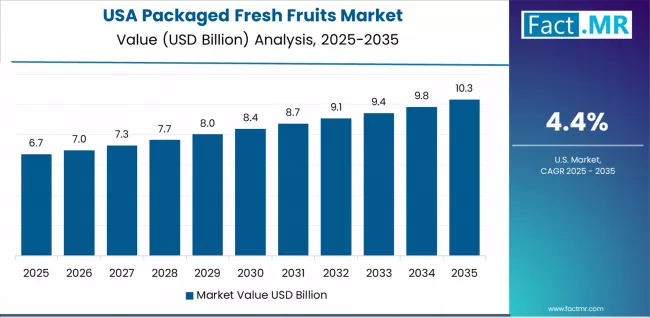
The USA is projected to grow at a CAGR of 4.4% through 2035, supported by the country's focus on health food advancement, organic product optimization, and premium retail system integration requiring efficient convenience solutions. American consumers and health-focused facilities prioritize product quality and nutritional precision, making specialized packaged fresh fruits essential components for both traditional and modern healthy eating applications. The country's comprehensive food technology leadership and advancing health patterns support continued market expansion.
- Advanced food technology capabilities and growing precision nutrition management are driving demand for packaged fresh fruits across specialty applications, premium retail formats, and health-integrated convenience programs serving domestic markets with increasing quality requirements.
- Strong focus on health optimization and product excellence is encouraging consumers and retailers to adopt fruit solutions that support wellness objectives and meet American quality standards for convenience food applications.
How is the United Kingdom maintaining steady growth through its focus on health foods?
The UK is projected to grow at a CAGR of 5.2% through 2035, supported by established retail standards, mature convenience markets, and focus on health optimization across retail and foodservice sectors. British consumers and food professionals prioritize quality nutrition and product consistency, creating steady demand for premium fruit solutions. The country's comprehensive market maturity and established food practices support continued development in specialized applications.
- Established retail markets and mature convenience industry are driving demand for quality packaged fresh fruits across retail operations, foodservice facilities, and professional food companies throughout British consumer regions.
- Strong focus on quality standards and health optimization is supporting the adoption of premium fruit varieties among consumers seeking proven nutrition and established food credentials in convenience applications.
How is Japan demonstrating quality-focused growth?
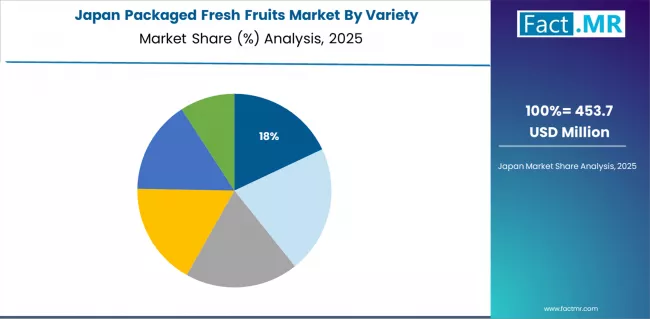
Japan is projected to grow at a CAGR of 2.7% through 2035, supported by the country's focus on quality excellence, product precision, and advanced food technology integration requiring premium convenience solutions. Japanese consumers and food-focused facilities prioritize product quality and presentation excellence, making specialized packaged fresh fruits essential components for both traditional and modern convenience food applications. The country's comprehensive quality leadership and advancing precision patterns support continued market expansion.
- Advanced quality food technology capabilities and growing premium convenience applications are driving demand for packaged fresh fruits across specialty food applications, premium retail formats, and quality-integrated food programs serving domestic markets with increasing excellence requirements.
- Strong focus on product precision and quality excellence is encouraging consumers and retailers to adopt fruit solutions that support quality objectives and meet Japanese precision standards for convenience food applications.
Europe Market Split by Country
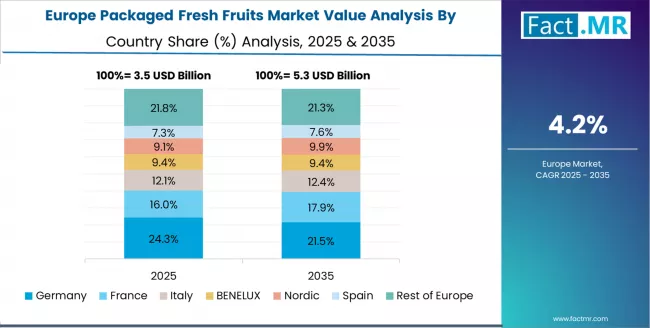
The Europe packaged fresh fruits market is projected to grow from USD 3.8 billion in 2025 to USD 6.2 billion by 2035, recording a CAGR of 5.0% over the forecast period. Germany leads the region with a 35.2% share in 2025, moderating slightly to 34.8% by 2035, supported by its strong retail traditions and demand for premium, quality-assured fruit products. The United Kingdom follows with 28.1% in 2025, easing to 27.6% by 2035, driven by a mature convenience food market and focus on health optimization and quality nutrition. France accounts for 16.4% in 2025, rising to 16.9% by 2035, reflecting steady adoption of premium food technologies and health consciousness. Italy holds 9.3% in 2025, expanding to 9.8% by 2035 as retail modernization and specialty food applications grow. Spain contributes 5.7% in 2025, growing to 6.1% by 2035, supported by expanding retail development and health awareness modernization. The Nordic countries rise from 3.1% in 2025 to 3.4% by 2035 on the back of strong health consciousness and advanced retail methodologies. BENELUX remains at 2.2% share across both 2025 and 2035, reflecting mature, quality-focused retail markets.
What is the competitive landscape of the packaged fresh fruits market?
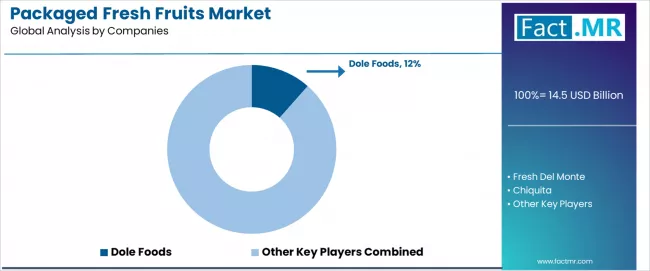
The market is characterized by competition among established food companies, specialized fresh produce processors, and integrated agricultural producers. Companies are investing in advanced packaging technologies, specialized preservation engineering, product innovation capabilities, and comprehensive distribution networks to deliver consistent, high-quality, and fresh fruit systems. Innovation in packaging optimization, preservation advancement, and nutrition-focused product development is central to strengthening market position and customer satisfaction.
Dole Foods leads the market with 11.5% share with a strong focus on fresh produce innovation and comprehensive fruit processing solutions, offering retail and foodservice systems with focus on quality excellence and agricultural heritage. Fresh Del Monte provides integrated fresh produce with a focus on premium market applications and global distribution networks. Chiquita delivers comprehensive fruit solutions with a focus on brand positioning and quality assurance. Sun-Maid specializes in comprehensive dried and fresh fruit systems with a focus on natural applications. Ocean Spray focuses on comprehensive berry products with premium quality and brand positioning capabilities.
Global Packaged Fresh Fruits Market - Stakeholder Contribution Framework
The success of packaged fresh fruits in meeting consumer convenience demands, health optimization requirements, and retail integration will not only enhance nutritional outcomes but also strengthen global food processing manufacturing capabilities. It will consolidate emerging regions' positions as hubs for efficient fruit processing and align advanced economies with comprehensive health food systems. This calls for a concerted effort by all stakeholders - governments, industry bodies, manufacturers, distributors, and investors. Each can be a crucial enabler in preparing the market for its next phase of growth.
How Governments Could Spur Local Production and Adoption?
- Targeted Incentives: Introduce food processing modernization subsidies for companies adopting advanced fruit packaging technologies in agricultural and processing regions, and production-linked incentives for facilities producing products for domestic consumption and export markets.
- Trade Agreements: Accelerate export growth through bilateral and multilateral agreements that classify packaged fresh fruits under "processed food products," easing cross-border regulatory approvals and food safety certifications.
- Facilitate Innovation: Establish Centers of Excellence for food technology innovation and packaging engineering. Fund R&D into efficient preservation systems, packaging optimization, and food-standard integration for retail and foodservice applications.
How Industry Bodies Could Support Market Development?
- Foster Connectivity: Constitute a global food processing consortium linking fruit processors, packaging suppliers, users, and policymakers to align production targets with health optimization and convenience commitments.
- Promote Exports: Work with export councils to brand packaged fresh fruits as premium, health-focused convenience solutions. Facilitate trade fairs to connect food technology innovators with global buyers in retail, foodservice, and institutional sectors.
- Upskilling Programs: Develop curricula on advanced fruit processing, packaging technology, food safety processes, and health optimization to prepare manufacturers and operators for premium food market opportunities.
How Distributors and Food Retail Players Could Strengthen the Ecosystem?
- Drive Integration: Bundle packaged fresh fruits with health-focused marketing and convenience messaging systems. Position specialized fruit products as part of holistic "healthy convenience solutions."
- Forge Partnerships: Collaborate with fruit processors and technology providers for joint R&D on convenience applications, health enhancement initiatives, and global quality assurance for premium markets.
How Manufacturers Could Navigate the Shift?
- Capture Premium Markets: Leverage government incentives and rising health demand to offer packaged fresh fruits into growth markets where traditional fresh produce faces convenience and preservation challenges.
- Invest in Technology: Partner with technology providers to advance efficient packaging workflows, food-grade quality, and advanced processing practices.
- Build Capabilities: Train technical staff and food specialists to demonstrate packaged fruits' nutritional advantages, repositioning retail relationships toward long-term health partnerships.
Key Players in the Packaged Fresh Fruits Market
- Dole Foods
- Fresh Del Monte
- Chiquita
- Sun-Maid
- Ocean Spray
- Driscoll's
- Wonderful Company
- Del Monte Foods
- Stemilt Growers
- Naturipe Farms
- Giumarra Companies
- Robinson Fresh
- Ready Pac Foods
Scope of the Report
| Items | Values |
|---|---|
| Quantitative Units (2025) | USD 14.5 billion |
| Variety | Apples, Bananas, Pineapples, Berries, Citrus Fruits, Other Varieties |
| Nature | Organic, Natural, Conventional, Others |
| Distribution Channel | Hypermarkets/Supermarkets, Online Retail, Convenience Stores, Other Retail |
| Packaging Type | Plastic Containers, Bags, Trays, Specialty Packaging |
| Regions Covered | North America, Europe, Asia Pacific, Latin America, Middle East & Africa, Other Regions |
| Countries Covered | China, India, Germany, Brazil, United States, United Kingdom, Japan, and 40+ countries |
| Key Companies Profiled | Dole Foods, Fresh Del Monte, Chiquita, Sun-Maid, Ocean Spray, and other leading packaged fresh fruit companies |
| Additional Attributes | Dollar sales by variety, nature, distribution channel, packaging type, and region; regional demand trends, competitive landscape, technological advancements in packaging engineering, preservation optimization initiatives, health enhancement programs, and premium product development strategies |
Packaged Fresh Fruits Market by Segments
-
Variety :
- Apples
- Bananas
- Pineapples
- Berries
- Citrus Fruits
- Other Varieties
-
Nature :
- Organic
- Natural
- Conventional
- Others
-
Distribution Channel :
- Hypermarkets/Supermarkets
- Online Retail
- Convenience Stores
- Other Retail
-
Packaging Type :
- Plastic Containers
- Bags
- Trays
- Specialty Packaging
-
Region :
- North America
- United States
- Canada
- Mexico
- Europe
- Germany
- United Kingdom
- France
- Italy
- Spain
- Nordic Countries
- BENELUX
- Rest of Europe
- Asia Pacific
- China
- India
- Japan
- South Korea
- Australia
- Rest of Asia Pacific
- Latin America
- Brazil
- Argentina
- Rest of Latin America
- Middle East & Africa
- Kingdom of Saudi Arabia
- United Arab Emirates
- South Africa
- Rest of Middle East & Africa
- Other Regions
- Oceania
- Central Asia
- Other Markets
- North America
Table of Content
- Executive Summary
- Global Market Outlook
- Demand to side Trends
- Supply to side Trends
- Technology Roadmap Analysis
- Analysis and Recommendations
- Market Overview
- Market Coverage / Taxonomy
- Market Definition / Scope / Limitations
- Market Background
- Market Dynamics
- Drivers
- Restraints
- Opportunity
- Trends
- Scenario Forecast
- Demand in Optimistic Scenario
- Demand in Likely Scenario
- Demand in Conservative Scenario
- Opportunity Map Analysis
- Product Life Cycle Analysis
- Supply Chain Analysis
- Investment Feasibility Matrix
- Value Chain Analysis
- PESTLE and Porter’s Analysis
- Regulatory Landscape
- Regional Parent Market Outlook
- Production and Consumption Statistics
- Import and Export Statistics
- Market Dynamics
- Global Market Analysis 2020 to 2024 and Forecast, 2025 to 2035
- Historical Market Size Value (USD Million) Analysis, 2020 to 2024
- Current and Future Market Size Value (USD Million) Projections, 2025 to 2035
- Y to o to Y Growth Trend Analysis
- Absolute $ Opportunity Analysis
- Global Market Pricing Analysis 2020 to 2024 and Forecast 2025 to 2035
- Global Market Analysis 2020 to 2024 and Forecast 2025 to 2035, By Variety
- Introduction / Key Findings
- Historical Market Size Value (USD Million) Analysis By Variety , 2020 to 2024
- Current and Future Market Size Value (USD Million) Analysis and Forecast By Variety , 2025 to 2035
- Apples
- Bananas
- Pineapples
- Berries
- Citrus Fruits
- Other Varieties
- Y to o to Y Growth Trend Analysis By Variety , 2020 to 2024
- Absolute $ Opportunity Analysis By Variety , 2025 to 2035
- Global Market Analysis 2020 to 2024 and Forecast 2025 to 2035, By Nature
- Introduction / Key Findings
- Historical Market Size Value (USD Million) Analysis By Nature, 2020 to 2024
- Current and Future Market Size Value (USD Million) Analysis and Forecast By Nature, 2025 to 2035
- Natural
- Organic
- Conventional
- Others
- Y to o to Y Growth Trend Analysis By Nature, 2020 to 2024
- Absolute $ Opportunity Analysis By Nature, 2025 to 2035
- Global Market Analysis 2020 to 2024 and Forecast 2025 to 2035, By Distribution Channel
- Introduction / Key Findings
- Historical Market Size Value (USD Million) Analysis By Distribution Channel, 2020 to 2024
- Current and Future Market Size Value (USD Million) Analysis and Forecast By Distribution Channel, 2025 to 2035
- Hypermarkets/Supermarkets
- Online Retail
- Convenience Stores
- Other Retail
- Y to o to Y Growth Trend Analysis By Distribution Channel, 2020 to 2024
- Absolute $ Opportunity Analysis By Distribution Channel, 2025 to 2035
- Global Market Analysis 2020 to 2024 and Forecast 2025 to 2035, By Region
- Introduction
- Historical Market Size Value (USD Million) Analysis By Region, 2020 to 2024
- Current Market Size Value (USD Million) Analysis and Forecast By Region, 2025 to 2035
- North America
- Latin America
- Western Europe
- Eastern Europe
- East Asia
- South Asia and Pacific
- Middle East & Africa
- Market Attractiveness Analysis By Region
- North America Market Analysis 2020 to 2024 and Forecast 2025 to 2035, By Country
- Historical Market Size Value (USD Million) Trend Analysis By Market Taxonomy, 2020 to 2024
- Market Size Value (USD Million) Forecast By Market Taxonomy, 2025 to 2035
- By Country
- USA
- Canada
- Mexico
- By Variety
- By Nature
- By Distribution Channel
- By Country
- Market Attractiveness Analysis
- By Country
- By Variety
- By Nature
- By Distribution Channel
- Key Takeaways
- Latin America Market Analysis 2020 to 2024 and Forecast 2025 to 2035, By Country
- Historical Market Size Value (USD Million) Trend Analysis By Market Taxonomy, 2020 to 2024
- Market Size Value (USD Million) Forecast By Market Taxonomy, 2025 to 2035
- By Country
- Brazil
- Chile
- Rest of Latin America
- By Variety
- By Nature
- By Distribution Channel
- By Country
- Market Attractiveness Analysis
- By Country
- By Variety
- By Nature
- By Distribution Channel
- Key Takeaways
- Western Europe Market Analysis 2020 to 2024 and Forecast 2025 to 2035, By Country
- Historical Market Size Value (USD Million) Trend Analysis By Market Taxonomy, 2020 to 2024
- Market Size Value (USD Million) Forecast By Market Taxonomy, 2025 to 2035
- By Country
- Germany
- UK
- Italy
- Spain
- France
- Nordic
- BENELUX
- Rest of Western Europe
- By Variety
- By Nature
- By Distribution Channel
- By Country
- Market Attractiveness Analysis
- By Country
- By Variety
- By Nature
- By Distribution Channel
- Key Takeaways
- Eastern Europe Market Analysis 2020 to 2024 and Forecast 2025 to 2035, By Country
- Historical Market Size Value (USD Million) Trend Analysis By Market Taxonomy, 2020 to 2024
- Market Size Value (USD Million) Forecast By Market Taxonomy, 2025 to 2035
- By Country
- Russia
- Poland
- Hungary
- Balkan & Baltic
- Rest of Eastern Europe
- By Variety
- By Nature
- By Distribution Channel
- By Country
- Market Attractiveness Analysis
- By Country
- By Variety
- By Nature
- By Distribution Channel
- Key Takeaways
- East Asia Market Analysis 2020 to 2024 and Forecast 2025 to 2035, By Country
- Historical Market Size Value (USD Million) Trend Analysis By Market Taxonomy, 2020 to 2024
- Market Size Value (USD Million) Forecast By Market Taxonomy, 2025 to 2035
- By Country
- China
- Japan
- South Korea
- By Variety
- By Nature
- By Distribution Channel
- By Country
- Market Attractiveness Analysis
- By Country
- By Variety
- By Nature
- By Distribution Channel
- Key Takeaways
- South Asia and Pacific Market Analysis 2020 to 2024 and Forecast 2025 to 2035, By Country
- Historical Market Size Value (USD Million) Trend Analysis By Market Taxonomy, 2020 to 2024
- Market Size Value (USD Million) Forecast By Market Taxonomy, 2025 to 2035
- By Country
- India
- ASEAN
- Australia & New Zealand
- Rest of South Asia and Pacific
- By Variety
- By Nature
- By Distribution Channel
- By Country
- Market Attractiveness Analysis
- By Country
- By Variety
- By Nature
- By Distribution Channel
- Key Takeaways
- Middle East & Africa Market Analysis 2020 to 2024 and Forecast 2025 to 2035, By Country
- Historical Market Size Value (USD Million) Trend Analysis By Market Taxonomy, 2020 to 2024
- Market Size Value (USD Million) Forecast By Market Taxonomy, 2025 to 2035
- By Country
- Kingdom of Saudi Arabia
- Other GCC Countries
- Turkiye
- South Africa
- Other African Union
- Rest of Middle East & Africa
- By Variety
- By Nature
- By Distribution Channel
- By Country
- Market Attractiveness Analysis
- By Country
- By Variety
- By Nature
- By Distribution Channel
- Key Takeaways
- Key Countries Market Analysis
- USA
- Pricing Analysis
- Market Share Analysis, 2024
- By Variety
- By Nature
- By Distribution Channel
- Canada
- Pricing Analysis
- Market Share Analysis, 2024
- By Variety
- By Nature
- By Distribution Channel
- Mexico
- Pricing Analysis
- Market Share Analysis, 2024
- By Variety
- By Nature
- By Distribution Channel
- Brazil
- Pricing Analysis
- Market Share Analysis, 2024
- By Variety
- By Nature
- By Distribution Channel
- Chile
- Pricing Analysis
- Market Share Analysis, 2024
- By Variety
- By Nature
- By Distribution Channel
- Germany
- Pricing Analysis
- Market Share Analysis, 2024
- By Variety
- By Nature
- By Distribution Channel
- UK
- Pricing Analysis
- Market Share Analysis, 2024
- By Variety
- By Nature
- By Distribution Channel
- Italy
- Pricing Analysis
- Market Share Analysis, 2024
- By Variety
- By Nature
- By Distribution Channel
- Spain
- Pricing Analysis
- Market Share Analysis, 2024
- By Variety
- By Nature
- By Distribution Channel
- France
- Pricing Analysis
- Market Share Analysis, 2024
- By Variety
- By Nature
- By Distribution Channel
- India
- Pricing Analysis
- Market Share Analysis, 2024
- By Variety
- By Nature
- By Distribution Channel
- ASEAN
- Pricing Analysis
- Market Share Analysis, 2024
- By Variety
- By Nature
- By Distribution Channel
- Australia & New Zealand
- Pricing Analysis
- Market Share Analysis, 2024
- By Variety
- By Nature
- By Distribution Channel
- China
- Pricing Analysis
- Market Share Analysis, 2024
- By Variety
- By Nature
- By Distribution Channel
- Japan
- Pricing Analysis
- Market Share Analysis, 2024
- By Variety
- By Nature
- By Distribution Channel
- South Korea
- Pricing Analysis
- Market Share Analysis, 2024
- By Variety
- By Nature
- By Distribution Channel
- Russia
- Pricing Analysis
- Market Share Analysis, 2024
- By Variety
- By Nature
- By Distribution Channel
- Poland
- Pricing Analysis
- Market Share Analysis, 2024
- By Variety
- By Nature
- By Distribution Channel
- Hungary
- Pricing Analysis
- Market Share Analysis, 2024
- By Variety
- By Nature
- By Distribution Channel
- Kingdom of Saudi Arabia
- Pricing Analysis
- Market Share Analysis, 2024
- By Variety
- By Nature
- By Distribution Channel
- Turkiye
- Pricing Analysis
- Market Share Analysis, 2024
- By Variety
- By Nature
- By Distribution Channel
- South Africa
- Pricing Analysis
- Market Share Analysis, 2024
- By Variety
- By Nature
- By Distribution Channel
- USA
- Market Structure Analysis
- Competition Dashboard
- Competition Benchmarking
- Market Share Analysis of Top Players
- By Regional
- By Variety
- By Nature
- By Distribution Channel
- Competition Analysis
- Competition Deep Dive
- Dole Foods
- Overview
- Product Portfolio
- Profitability by Market Segments (Product/Age /Sales Channel/Region)
- Sales Footprint
- Strategy Overview
- Marketing Strategy
- Product Strategy
- Channel Strategy
- Fresh Del Monte
- Chiquita
- Sun-Maid
- Ocean Spray
- Driscoll's
- Wonderful Company
- Del Monte Foods
- Stemilt Growers
- Naturipe Farms
- Giumarra Companies
- Robinson Fresh
- Ready Pac Foods
- Dole Foods
- Competition Deep Dive
- Assumptions & Acronyms Used
- Research Methodology
List Of Table
- Table 1: Global Market Value (USD Million) Forecast by Region, 2020 to 2035
- Table 2: Global Market Value (USD Million) Forecast by Variety , 2020 to 2035
- Table 3: Global Market Value (USD Million) Forecast by Nature, 2020 to 2035
- Table 4: Global Market Value (USD Million) Forecast by Distribution Channel, 2020 to 2035
- Table 5: North America Market Value (USD Million) Forecast by Country, 2020 to 2035
- Table 6: North America Market Value (USD Million) Forecast by Variety , 2020 to 2035
- Table 7: North America Market Value (USD Million) Forecast by Nature, 2020 to 2035
- Table 8: North America Market Value (USD Million) Forecast by Distribution Channel, 2020 to 2035
- Table 9: Latin America Market Value (USD Million) Forecast by Country, 2020 to 2035
- Table 10: Latin America Market Value (USD Million) Forecast by Variety , 2020 to 2035
- Table 11: Latin America Market Value (USD Million) Forecast by Nature, 2020 to 2035
- Table 12: Latin America Market Value (USD Million) Forecast by Distribution Channel, 2020 to 2035
- Table 13: Western Europe Market Value (USD Million) Forecast by Country, 2020 to 2035
- Table 14: Western Europe Market Value (USD Million) Forecast by Variety , 2020 to 2035
- Table 15: Western Europe Market Value (USD Million) Forecast by Nature, 2020 to 2035
- Table 16: Western Europe Market Value (USD Million) Forecast by Distribution Channel, 2020 to 2035
- Table 17: Eastern Europe Market Value (USD Million) Forecast by Country, 2020 to 2035
- Table 18: Eastern Europe Market Value (USD Million) Forecast by Variety , 2020 to 2035
- Table 19: Eastern Europe Market Value (USD Million) Forecast by Nature, 2020 to 2035
- Table 20: Eastern Europe Market Value (USD Million) Forecast by Distribution Channel, 2020 to 2035
- Table 21: East Asia Market Value (USD Million) Forecast by Country, 2020 to 2035
- Table 22: East Asia Market Value (USD Million) Forecast by Variety , 2020 to 2035
- Table 23: East Asia Market Value (USD Million) Forecast by Nature, 2020 to 2035
- Table 24: East Asia Market Value (USD Million) Forecast by Distribution Channel, 2020 to 2035
- Table 25: South Asia and Pacific Market Value (USD Million) Forecast by Country, 2020 to 2035
- Table 26: South Asia and Pacific Market Value (USD Million) Forecast by Variety , 2020 to 2035
- Table 27: South Asia and Pacific Market Value (USD Million) Forecast by Nature, 2020 to 2035
- Table 28: South Asia and Pacific Market Value (USD Million) Forecast by Distribution Channel, 2020 to 2035
- Table 29: Middle East & Africa Market Value (USD Million) Forecast by Country, 2020 to 2035
- Table 30: Middle East & Africa Market Value (USD Million) Forecast by Variety , 2020 to 2035
- Table 31: Middle East & Africa Market Value (USD Million) Forecast by Nature, 2020 to 2035
- Table 32: Middle East & Africa Market Value (USD Million) Forecast by Distribution Channel, 2020 to 2035
List Of Figures
- Figure 1: Global Market Pricing Analysis
- Figure 2: Global Market Value (USD Million) Forecast 2020-2035
- Figure 3: Global Market Value Share and BPS Analysis by Variety , 2025 and 2035
- Figure 4: Global Market Y to o to Y Growth Comparison by Variety , 2025-2035
- Figure 5: Global Market Attractiveness Analysis by Variety
- Figure 6: Global Market Value Share and BPS Analysis by Nature, 2025 and 2035
- Figure 7: Global Market Y to o to Y Growth Comparison by Nature, 2025-2035
- Figure 8: Global Market Attractiveness Analysis by Nature
- Figure 9: Global Market Value Share and BPS Analysis by Distribution Channel, 2025 and 2035
- Figure 10: Global Market Y to o to Y Growth Comparison by Distribution Channel, 2025-2035
- Figure 11: Global Market Attractiveness Analysis by Distribution Channel
- Figure 12: Global Market Value (USD Million) Share and BPS Analysis by Region, 2025 and 2035
- Figure 13: Global Market Y to o to Y Growth Comparison by Region, 2025-2035
- Figure 14: Global Market Attractiveness Analysis by Region
- Figure 15: North America Market Incremental Dollar Opportunity, 2025-2035
- Figure 16: Latin America Market Incremental Dollar Opportunity, 2025-2035
- Figure 17: Western Europe Market Incremental Dollar Opportunity, 2025-2035
- Figure 18: Eastern Europe Market Incremental Dollar Opportunity, 2025-2035
- Figure 19: East Asia Market Incremental Dollar Opportunity, 2025-2035
- Figure 20: South Asia and Pacific Market Incremental Dollar Opportunity, 2025-2035
- Figure 21: Middle East & Africa Market Incremental Dollar Opportunity, 2025-2035
- Figure 22: North America Market Value Share and BPS Analysis by Country, 2025 and 2035
- Figure 23: North America Market Value Share and BPS Analysis by Variety , 2025 and 2035
- Figure 24: North America Market Y to o to Y Growth Comparison by Variety , 2025-2035
- Figure 25: North America Market Attractiveness Analysis by Variety
- Figure 26: North America Market Value Share and BPS Analysis by Nature, 2025 and 2035
- Figure 27: North America Market Y to o to Y Growth Comparison by Nature, 2025-2035
- Figure 28: North America Market Attractiveness Analysis by Nature
- Figure 29: North America Market Value Share and BPS Analysis by Distribution Channel, 2025 and 2035
- Figure 30: North America Market Y to o to Y Growth Comparison by Distribution Channel, 2025-2035
- Figure 31: North America Market Attractiveness Analysis by Distribution Channel
- Figure 32: Latin America Market Value Share and BPS Analysis by Country, 2025 and 2035
- Figure 33: Latin America Market Value Share and BPS Analysis by Variety , 2025 and 2035
- Figure 34: Latin America Market Y to o to Y Growth Comparison by Variety , 2025-2035
- Figure 35: Latin America Market Attractiveness Analysis by Variety
- Figure 36: Latin America Market Value Share and BPS Analysis by Nature, 2025 and 2035
- Figure 37: Latin America Market Y to o to Y Growth Comparison by Nature, 2025-2035
- Figure 38: Latin America Market Attractiveness Analysis by Nature
- Figure 39: Latin America Market Value Share and BPS Analysis by Distribution Channel, 2025 and 2035
- Figure 40: Latin America Market Y to o to Y Growth Comparison by Distribution Channel, 2025-2035
- Figure 41: Latin America Market Attractiveness Analysis by Distribution Channel
- Figure 42: Western Europe Market Value Share and BPS Analysis by Country, 2025 and 2035
- Figure 43: Western Europe Market Value Share and BPS Analysis by Variety , 2025 and 2035
- Figure 44: Western Europe Market Y to o to Y Growth Comparison by Variety , 2025-2035
- Figure 45: Western Europe Market Attractiveness Analysis by Variety
- Figure 46: Western Europe Market Value Share and BPS Analysis by Nature, 2025 and 2035
- Figure 47: Western Europe Market Y to o to Y Growth Comparison by Nature, 2025-2035
- Figure 48: Western Europe Market Attractiveness Analysis by Nature
- Figure 49: Western Europe Market Value Share and BPS Analysis by Distribution Channel, 2025 and 2035
- Figure 50: Western Europe Market Y to o to Y Growth Comparison by Distribution Channel, 2025-2035
- Figure 51: Western Europe Market Attractiveness Analysis by Distribution Channel
- Figure 52: Eastern Europe Market Value Share and BPS Analysis by Country, 2025 and 2035
- Figure 53: Eastern Europe Market Value Share and BPS Analysis by Variety , 2025 and 2035
- Figure 54: Eastern Europe Market Y to o to Y Growth Comparison by Variety , 2025-2035
- Figure 55: Eastern Europe Market Attractiveness Analysis by Variety
- Figure 56: Eastern Europe Market Value Share and BPS Analysis by Nature, 2025 and 2035
- Figure 57: Eastern Europe Market Y to o to Y Growth Comparison by Nature, 2025-2035
- Figure 58: Eastern Europe Market Attractiveness Analysis by Nature
- Figure 59: Eastern Europe Market Value Share and BPS Analysis by Distribution Channel, 2025 and 2035
- Figure 60: Eastern Europe Market Y to o to Y Growth Comparison by Distribution Channel, 2025-2035
- Figure 61: Eastern Europe Market Attractiveness Analysis by Distribution Channel
- Figure 62: East Asia Market Value Share and BPS Analysis by Country, 2025 and 2035
- Figure 63: East Asia Market Value Share and BPS Analysis by Variety , 2025 and 2035
- Figure 64: East Asia Market Y to o to Y Growth Comparison by Variety , 2025-2035
- Figure 65: East Asia Market Attractiveness Analysis by Variety
- Figure 66: East Asia Market Value Share and BPS Analysis by Nature, 2025 and 2035
- Figure 67: East Asia Market Y to o to Y Growth Comparison by Nature, 2025-2035
- Figure 68: East Asia Market Attractiveness Analysis by Nature
- Figure 69: East Asia Market Value Share and BPS Analysis by Distribution Channel, 2025 and 2035
- Figure 70: East Asia Market Y to o to Y Growth Comparison by Distribution Channel, 2025-2035
- Figure 71: East Asia Market Attractiveness Analysis by Distribution Channel
- Figure 72: South Asia and Pacific Market Value Share and BPS Analysis by Country, 2025 and 2035
- Figure 73: South Asia and Pacific Market Value Share and BPS Analysis by Variety , 2025 and 2035
- Figure 74: South Asia and Pacific Market Y to o to Y Growth Comparison by Variety , 2025-2035
- Figure 75: South Asia and Pacific Market Attractiveness Analysis by Variety
- Figure 76: South Asia and Pacific Market Value Share and BPS Analysis by Nature, 2025 and 2035
- Figure 77: South Asia and Pacific Market Y to o to Y Growth Comparison by Nature, 2025-2035
- Figure 78: South Asia and Pacific Market Attractiveness Analysis by Nature
- Figure 79: South Asia and Pacific Market Value Share and BPS Analysis by Distribution Channel, 2025 and 2035
- Figure 80: South Asia and Pacific Market Y to o to Y Growth Comparison by Distribution Channel, 2025-2035
- Figure 81: South Asia and Pacific Market Attractiveness Analysis by Distribution Channel
- Figure 82: Middle East & Africa Market Value Share and BPS Analysis by Country, 2025 and 2035
- Figure 83: Middle East & Africa Market Value Share and BPS Analysis by Variety , 2025 and 2035
- Figure 84: Middle East & Africa Market Y to o to Y Growth Comparison by Variety , 2025-2035
- Figure 85: Middle East & Africa Market Attractiveness Analysis by Variety
- Figure 86: Middle East & Africa Market Value Share and BPS Analysis by Nature, 2025 and 2035
- Figure 87: Middle East & Africa Market Y to o to Y Growth Comparison by Nature, 2025-2035
- Figure 88: Middle East & Africa Market Attractiveness Analysis by Nature
- Figure 89: Middle East & Africa Market Value Share and BPS Analysis by Distribution Channel, 2025 and 2035
- Figure 90: Middle East & Africa Market Y to o to Y Growth Comparison by Distribution Channel, 2025-2035
- Figure 91: Middle East & Africa Market Attractiveness Analysis by Distribution Channel
- Figure 92: Global Market - Tier Structure Analysis
- Figure 93: Global Market - Company Share Analysis
- FAQs -
How big is the packaged fresh fruits market in 2025?
The global packaged fresh fruits market is estimated to be valued at USD 14.5 billion in 2025.
What will be the size of packaged fresh fruits market in 2035?
The market size for the packaged fresh fruits market is projected to reach USD 25.2 billion by 2035.
How much will be the packaged fresh fruits market growth between 2025 and 2035?
The packaged fresh fruits market is expected to grow at a 5.7% CAGR between 2025 and 2035.
What are the key product types in the packaged fresh fruits market?
The key product types in packaged fresh fruits market are apples, bananas, pineapples, berries, citrus fruits and other varieties.
Which nature segment to contribute significant share in the packaged fresh fruits market in 2025?
In terms of nature, natural segment to command 50.0% share in the packaged fresh fruits market in 2025.